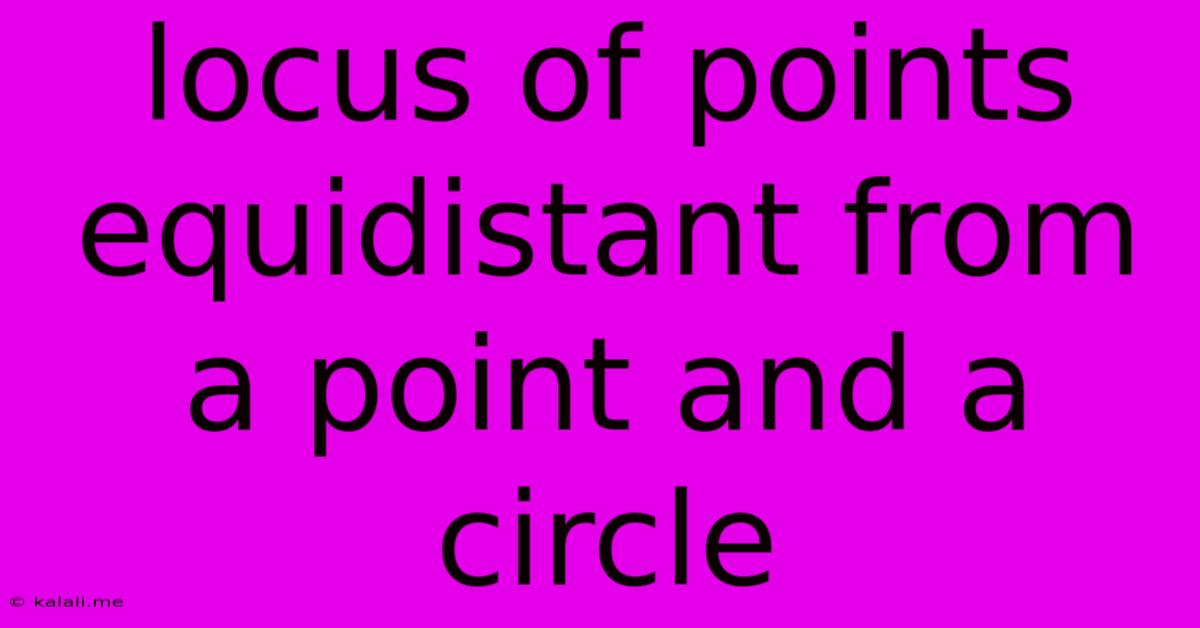Locus Of Points Equidistant From A Point And A Circle
Kalali
Jun 07, 2025 · 3 min read

Table of Contents
The Locus of Points Equidistant from a Point and a Circle
This article explores the fascinating geometric concept of the locus of points equidistant from a given point and a given circle. We'll delve into the definition, explore different scenarios, and discuss how to construct and understand this locus. Understanding this concept provides valuable insights into analytical geometry and problem-solving in mathematics.
What is a Locus?
Before diving into the specifics, let's define a locus. In geometry, a locus is a set of points that satisfy a particular condition or set of conditions. For example, the locus of points equidistant from two given points is the perpendicular bisector of the line segment connecting those points. In our case, the condition is equidistance from a point and a circle.
Defining the Problem: Equidistant from a Point and a Circle
We are looking for all points (x, y) that are the same distance from a fixed point (let's call it P) and the circumference of a fixed circle (let's call it C). This means the distance from a point on the locus to P is equal to the distance from that same point to the nearest point on the circumference of circle C.
Scenarios and Solutions
The shape of the locus depends significantly on the relative positions of point P and circle C:
1. Point P Lies Inside the Circle:
In this case, the locus will consist of two branches. These branches form a curve that resembles a stretched oval, technically called a cassini oval. Imagine drawing concentric circles around point P. When these circles intersect the circle C, the points of intersection define the distance from P that satisfies the equidistance condition. Each point on these intersection arcs will fulfill the requirement of being equidistant from P and the nearest point on circle C. These intersection points form the locus. The exact equation for this locus is complex and often requires advanced mathematical techniques to derive. However, the visual representation is intuitive if you imagine intersecting circles.
2. Point P Lies on the Circle:
If point P is on the circle C, the locus simplifies considerably. It becomes a single straight line through point P, perpendicular to the radius of the circle that passes through P. This line is effectively the perpendicular bisector of the radius that intersects point P on the circle.
3. Point P Lies Outside the Circle:
When P is outside the circle C, the locus forms a single continuous closed curve, again reminiscent of a stretched oval, potentially more elongated than the one in scenario 1. Similar to the inside case, it can be conceptually visualized by considering the intersection of circles centered at P and the circle C. The outermost intersecting points form the continuous locus curve.
Constructing the Locus
While deriving the precise equation for the locus can be challenging, its construction can be approached using geometrical techniques. The procedure involves drawing a series of circles centered at P and finding their intersections with circle C (or its equivalent when P is inside the circle). These intersections will be points on the locus. Connecting these points gives a good approximation of the curve. Software like GeoGebra can significantly ease this process.
Applications and Significance
Understanding the locus of points equidistant from a point and a circle has applications in various fields, including:
- Engineering: Designing systems with equal signal strength from a transmitter and a reflective surface.
- Physics: Modeling certain types of wave interference patterns.
- Computer Graphics: Generating aesthetically pleasing curves for design purposes.
Conclusion
The locus of points equidistant from a point and a circle, while seemingly simple in its definition, presents a rich geometric problem with visually appealing and mathematically interesting solutions. The shape of the locus depends critically on the relative positions of the point and the circle, leading to different types of curves with unique characteristics. Understanding this concept enriches your geometrical intuition and provides valuable tools for solving more complex problems.
Latest Posts
Latest Posts
-
Why Isnt Alfred File Search Working Ventura
Jun 07, 2025
-
Scriptures On The Last Days In The Bible
Jun 07, 2025
-
Can Incholate Crimes Involver A Minor Pretending To Be Someone
Jun 07, 2025
-
How Should Dispose Of Old Clogged Dryer Vent Piping
Jun 07, 2025
-
Did Both Thieves On The Cross Mock Jesus
Jun 07, 2025
Related Post
Thank you for visiting our website which covers about Locus Of Points Equidistant From A Point And A Circle . We hope the information provided has been useful to you. Feel free to contact us if you have any questions or need further assistance. See you next time and don't miss to bookmark.